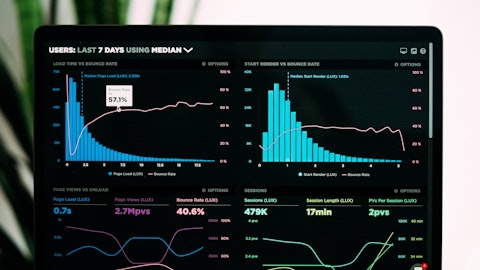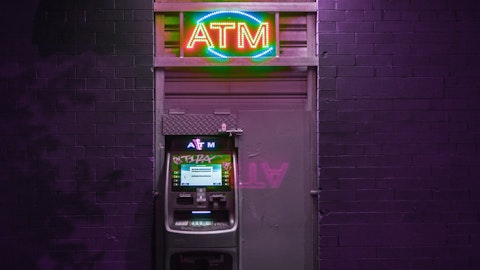KeyCorp (NYSE:KEY) Q2 2023 Earnings Call Transcript July 20, 2023
KeyCorp misses on earnings expectations. Reported EPS is $0.27 EPS, expectations were $0.31.
Operator: Good morning, and welcome to KeyCorp’s Second Quarter 2023 Earnings Conference Call. As a reminder, this conference is being recorded. I would now like to turn the conference over to the Chairman and CEO, Chris Gorman. Please go ahead.
Chris Gorman: Thank you for joining us for KeyCorp’s Second Quarter 2023 Earnings Conference Call. Joining me on the call today are Clark Khayat, our Chief Financial Officer; and Mark Midkiff, our Chief Risk Officer. On Slide 2, you will find our statement on forward-looking disclosure and certain financial measures, including non-GAAP measures. These statements cover our presentation materials and comments as well as the question-and-answer segment of our call. I am now moving to Slide 3. Before Clark covers our quarterly earnings results, I want to discuss our strategic priorities and cover the fundamental strengths of our businesses, which continue to perform well despite the challenging operating environment. In our Consumer Bank, we’re growing relationship households at an annualized rate of 5%, consistent with our Investor Day target.
Our strongest growth continues to be in the West, driven by younger clients. We have also experienced strong growth in wealth management with double-digit year-over-year growth in asset management sales. In our Commercial business, we continue to add and expand relationships through our integrated commercial and investment bank. Our ability to distribute risk serves us well and importantly, serves our clients well through all market conditions. This quarter, we raised $25 billion of capital for our clients, placing 18% of the capital raised on our balance sheet. This is down significantly from the 30% we placed on our balance sheet last quarter. Although capital markets remain challenged, our pipelines are solid. On a year-to-date basis, our M&A revenue is up from the first half of 2022.
We expect investment banking fees to be up in the second half of the year. One common theme across our franchises are long-standing strategic commitment to Primacy, having our clients’ primary operating account, whether it’s an individual or a business. Our focus on primacy is reflected in the quality and diversity of our deposit base. Nearly 60% of our deposits are from retail, small business, wealth and escrow accounts. 80% of our commercial balances are core operating accounts. Further, 97% of our total commercial deposits are from our relationship clients. Importantly, these are long-standing relationships. On average, our retail clients have been clients of key for over 20 years and on average, our commercial clients for over 15 years.
This quarter, our period end deposits increased by $1 billion. Additionally, we’ve seen continued growth in the month of July. In the appendix of our presentation, you can find additional detail regarding the quality and diversity of our deposit base. We continue to proactively manage through volatility as it relates to the macroeconomic environment, the interest rate cycle and potential regulatory changes impacting our industry. Going forward, Key will benefit from a well-defined net interest income opportunity over the next 18 months. As our short-term swaps and treasuries reprice, we will see a net interest income benefit that will reach approximately $900 million on an annual basis by the first quarter of 2025. We also continue to be proactive from both a balance sheet optimization and capital allocation perspective.
We are well positioned to build capital and reduce risk-weighted assets. We will continue to prioritize full relationships and exit non-relationship business and non-strategic assets. In the second quarter, our period-end loan balances declined by $1 billion. We will continue to benefit from our strong fee-based businesses, which make up over 40% of our revenue. As capital markets normalize, we will utilize our differentiated platform, driving fee income and naturally reducing our balance sheet. On the capital front, we will benefit as over 44% of our AOCI will roll down over the next 18 months. The next area, I would like to discuss is our exposure to credit in the current environment. Credit losses remained relatively low across the industry.
But as we move through the business cycle, asset quality will matter. Today, more than half of our C&I loans are investment grade and over 70% of our consumer originations have a FICO score of 760 or greater. These measures reflect the derisking of our portfolio over the past decade in concert with our underwrite to distribute model. We have limited exposure to leveraged lending, office loans and other high risk categories. B and C class office exposure in Central Business Districts totaled $121 million, two-thirds of our commercial real estate exposure is in multifamily, including affordable housing, which continues to be a significant unmet need in this country. We also continue to benefit from insights gained from our third-party commercial real estate servicing business, as we service over $630 billion of off us real estate exposure.
Finally, we will continue to focus on improving productivity and efficiency. Our results this quarter reflect the successful completion earlier this year of a company-wide effort to improve efficiency. Actions completed in the first quarter represented over 4% of our expense base and $200 million in annualized benefit. These efforts remain ongoing as we will identify new opportunities to improve both productivity and efficiency. Before turning the call over to Clark, I want to take a step back. This quarter, we strategically built capital, managed the size of our balance sheet and for the third consecutive quarter, built our allowance for credit losses. As I covered earlier, we will continue to take steps to manage our level of risk-weighted assets in consideration of anticipated regulatory changes.
I will close by affirming my confidence is long-term outlook for our business. We have a durable relationship-based business model that will continue to serve our clients, our prospects and deliver value to our shareholders. With that, I’ll turn it over to Clark to provide more details on the results for the quarter. Clark?

100 Euro (EUR), and 100 Dollar (USD) banknotes placed back-to-back horizontally on a reflecting surface.
Clark Khayat: Thanks, Chris. I’m now on Slide 5. For the second quarter, net income from continuing operations was $0.27 per common share, down $0.03 from the prior quarter, and down $0.27 from last year, driven in part by two notable items. Our results included $87 million of additional post-tax provision expense in excess of net charge-offs or $0.09 per share as we continue to build our reserves. We also incurred $21 million of notable post-tax expenses or $0.02 per share. This includes severance costs, refunds on fees and related claims and a Visa, Class B fair value adjustment. Turning to Slide 6. Average loans for the quarter were $120.7 billion, up 11% from the year ago period and up less than 1% from the prior quarter as we continue to support relationship clients.
Commercial loans increased 12% from the year ago quarter. Relative to the same period, consumer loans increased 7%. Compared with the first quarter of 2023, commercial loans grew 1%, while consumer loans remained relatively stable. Total loans ended the period at $119 billion, down $1 billion from the prior quarter. Continuing on to Slide 7. Key’s long-standing commitment to privacy continues to support a stable, diverse base of core deposits for funding. Our total cost of deposits was 149 basis points in Q2 and our cumulative deposit beta was 39% since the Fed began raising interest rates in March 2022. We remain focused on balance sheet management with an eye toward minimizing the total cost of funds. Average deposits totaled $142.9 billion for the second quarter of 2023, down 3% from the year ago period and were relatively stable across the quarter, down approximately $500 million on average.
Year-over-year, we saw declines in retail deposits, driven by elevated spend due to inflation, normalization from elevated pandemic levels and changing client behavior due to higher rates. The decrease in average deposit balances from the prior quarter reflects a continuation of the same trends. Regular seasonal outflows that we saw in April were more than offset in May and June. Deposits ended the period at $145.1 billion, up $1 billion from the prior quarter. Turning to Slide 8. Taxable equivalent net interest income was $986 million for the second quarter compared with $1.1 billion in the year ago and prior quarters, down approximately 11% against both periods. Our net interest margin was 2.12% for the second quarter compared to 2.61% for the same period last year and 2.47% for the prior quarter.
Year-over-year, net interest income and the net interest margin were impacted by higher interest-bearing deposit costs, a shift in funding mix to higher cost deposits and growth in wholesale borrowings, which in part supported elevated cash levels. The decline in net interest income was partially offset by higher yield on loans and investments. Relative to the first quarter, our net interest margin was negatively impacted by 28 basis points related to higher interest-bearing deposit costs and 17 basis points from a change in funding mix and liquidity, partly offset by 10 basis points related to higher earning asset yields and earning asset growth. Our swap portfolio and short-dated treasuries reduced net interest income by $340 million and lowered our net interest margin by 73 basis points this quarter.
Turning to Slide 9. As previously mentioned, Key has begun to benefit from the maturity of our short-dated swap book, and expects to begin to benefit more significantly from increasing swap and treasury maturities as we move forward. Based on the forward curve, we continue to expect a meaningful benefit, currently estimated at $900 million annualized in the first quarter of 2025. We have continued to take a measured but opportunistic approach to lock in this potential benefit, and this analysis includes the addition of hedging activity undertaken beginning in 4Q 2022 and since. We have not and do not plan to replace the swaps rolling off in 2023, instead allowing natural asset sensitivity of the loan book to come through and benefit from higher short-term rates.
Moving to Slide 10. Non-interest income was $609 million for the second quarter of 2023, compared to $688 million for the year ago period and $608 million in the first quarter. The decline in non-interest income from the year ago period reflects a $29 million decline in investment banking and debt placement fees, reflecting lower advisory and syndication fees. Additionally, service charges on deposit accounts declined $27 million, reflecting previously announced and implemented changes in our NSF/OD fee structure and lower account analysis fees related to higher interest rates. The decline in non-interest income from the first quarter reflects a $25 million decline in investment banking and debt placement driven by lower advisory and syndication fees, partially offset by a $10 million increase in corporate services income, reflecting an increase in customer derivative activity.
I’m now on Slide 11. Total non-interest expense for the quarter was $1.076 billion, down $2 million from the year ago period and down $100 million from last quarter. Compared with the year ago quarter, net occupancy expense decreased $13 million, reflecting a downsizing of corporate facilities and business service and professional fees decreased $11 million. These decreases were partially offset by a $17 million increase in technology expense and a $15 million increase in personnel expense, reflecting merit increases and higher benefit costs. Compared to the prior quarter, personnel expense decreased $79 million, reflecting lower incentive, stock-based compensation and severance. Additionally, other expense decreased $24 million in the second quarter as the first quarter included restructuring charges related to expense actions.
Moving now to Slide 12. Overall credit quality remains solid. For the second quarter, net charge-offs were $52 million, or 17 basis points of average loans. Delinquencies across portfolio has remained relatively stable. Our provision for credit losses was $167 million for the second quarter, which as we have pointed out, exceeded net charge $115 [ph] million, or $87 million after tax. The excess provision increases our allowance for credit losses to 1.49% of period-end loans. Despite the increase in the allowance, our outlook for net charge-offs remains well below our through-the-cycle targeted level of 40 basis points to 60 basis points. Now on to Slide 13. We ended the second quarter with a Common Equity Tier 1 ratio of 9.2%, up from the prior quarter and within our targeted range of 9% to 9.5%.
This provides us with sufficient capacity to continue to support our relationship customers and their needs. We did not complete any open market share represents in the second order being unmotivated to employee compensation, nor do we expect to engage into material share repurchases in the near term. We will continue to focus our capital and supporting relationship client activity and paying dividends. On the right side of the slide is the expected reduction in our AOCI mark. The AOCI mark declines by approximately 44% by the end of 2024, and 55% by the end of 2025. In alignment with recent public remarks from regulators, we expect that any changes will be implemented with an appropriate comments and phase-in period. Given that, our view is that for any new requirements or reduction in AOCI marks and, more significantly, our future earnings and balance sheet management would allow us to organically accrete capital to the required levels over the necessary period.
Slide 14 provides an outlook for the third and fourth quarter of 2023. Third and fourth quarter guidance is given relative to each prior quarter respectively. Similar to our approach in the third quarter of last year, we have shifted our guidance to focus on quarterly results. This provides a clear view of trends heading into year-end using the forward curve as of July 1. Balance sheet trends are tracking mostly as anticipated. We expect average loans to be down 1% to 3% in both the third and fourth quarter versus the prior quarter as we continue to actively manage our balance sheet and recycle capital to support relationship clients. We expect average deposits to be relatively stable in both the third and fourth quarter versus prior periods.
Our outlook assumes a cumulative deposit beta approaching 50 by year-end. On a linked-quarter basis, net interest income is expected to decline 4% to 6% in the third quarter and be flat to down 2% in the fourth quarter. As we drive more benefit from the repricing of our swaps and treasuries in 2024, we expect growth in both our net interest income and net interest margin. Our guidance assumes a Fed funds rate reaching 5.5% in the third quarter, remaining flat through year-end. These interest rate assumptions, along with our expectations for customer behavior and the competitive pricing environment, are very fluid and will continue to impact our outlook prospectively. Non-interest income is estimated to be up 2% to 4% in the third quarter and up 4% to 6% in the fourth quarter versus prior periods, reflecting a gradual improvement in capital markets.
Non-interest expense is expected to remain relatively stable in both the third and fourth quarters. We assume credit quality remains solid in net charge-offs to average loans to be in the range of 20 to 25 basis points in the third quarter and 25 to 35 basis points in the fourth quarter, both below our expected over-the-cycle targeted range of 40 to 60 basis points. Our guidance for the third and fourth quarter GAAP tax rate is 18% to 19%. Using our quarterly guidance, our full year outlook for 2023 versus the prior year would be the following: net interest income down 12% to 14%, fees down 7% to 9%, expenses relatively stable, net charge-offs of 25 to 30 basis points for the year and a GAAP tax rate of 18% to 19%. We feel confident in the foundation of our business, in our diverse high-quality deposit base the durability of our balanced franchise and our improved risk profile.
Despite near-term headwinds, we continue to be focused on execution in 2023 and positioning the company to benefit from the strong long-term core earnings power of our businesses. With that, I will now turn the call back to the operator for instructions for the Q&A portion of our call. Operator?
See also 20 Biggest Toy Companies in the World and 15 Biggest Clothing Manufacturing Countries in the World.
Q&A Session
Follow Keycorp W (NYSE:KEY)
Follow Keycorp W (NYSE:KEY)
Operator: Thank you. [Operator Instructions] One moment, at least for the first question. That will come from the line of Scott Siefers with Piper Sandler.
Scott Siefers: Good morning, guys. Thank you.
Chris Gorman: Good morning, Scott.
Scott Siefers: Hey, Clark I wanted to talk about the NII outlook. So the pace of NII degradation looks like it should slow considerably in the second half, the fourth quarter, especially. Maybe a little more color on the main factors you see that would allow that to happen. I know you sort of rationalize the beta expectation, and of course you’ve got the treasuries and swaps, but just curious to hear from your view, the sort of main factors in that outlook?
Clark Khayat: Sure. Thanks, Scott. And I think this will be a topic worth spending a little time on. So first, let me just remind you that the 212 NIM would have been 285 without the swaps and treasuries, which were about $340 million in the quarter, just to give you kind of a level set. If we go back to recent — the most recent guidance, we would have guided you to the second quarter being at or near the bottom. So to your point, Scott, it’s a little bit of a continued decline. What I’d say is the fundamentals of our business are very consistent with that comment. What’s changed is the rate expectation in the back half of the year. So at that time, we were expecting two cuts in the fourth quarter. As I stated in the prepared remarks, we’re now going to see kind of a one hike and it flat through the end of the year.
And I think the implication of that is the betas will drift a little higher through the back half of the year, and the swaps and the treasuries will be a little bit bigger drag than we previously expected. That said, we do think that both of those factors are moderating. So we’re seeing deposit balances stabilize, and we’re seeing the slope of that beta increase flatten. And we’re continuing to see swaps mature and the treasury portfolio will begin to mature now in the third quarter. So we’ll see opportunity as those two books come off. So what we’re seeing then is that flattening of the NII and NIM trajectory as we go into fourth quarter, and we wanted to reflect that by providing guidance for each individual quarter. As we go beyond that into 2024, I think we’ll start to see a pickup.
Slide 9 isolates the swap and treasury portfolio, so consistent with what we did last quarter. As I stated a few minutes ago, $340 million drag in Q2 or 73 basis points. And the way I’d think about it just in its simplest terms is $9 million US treasuries that start maturing in this quarter, with basically an average yield, think, of 45 basis points and $10.3 billion of swaps between now and the end of 2024, with a received fixed rate between 40 and 50 basis points. So put those together, you’re looking at close to $20 billion with an almost 5% yield pickup by the end of 2024, and that’s what gets you to the $90 million or 220 per quarter — 230, sorry, per quarter that we have on slide 9 in the deck as of Q1 2025. So again, in that case, we’re trying to isolate just the treasuries and swaps and provide as much transparency as we can there on these specific headwinds.





